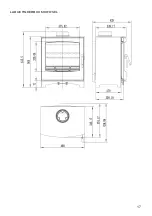
5
1.3 TRANSPORTATION
When taking your wood burning stove home,
please ensure that it travels in an upright position.
If you wish to lay it flat, it is important that you
remove all loose parts from the combustion
chamber.
Your new wood stove is optimally protected
against damage by the packaging. However,
damages to the stove or accessories may have
occurred during the transport despite this.
For this reason, it is necessary to check your
wood stove for damages and completeness after
unpacking!
Immediately report any defects to your specialist
stove dealer!
Note: This appliance is heavy and must be
handled with care. Adequate facilities must
be available for loading, unloading and site
handling.
2. INSTALLATION OF THE STOVE
2.1 PRE-INSTALLATION
It is a
legal
requirement under England and Wales
building regulations that the installation of the
stove is carried out under local authority building
control approval or installed by a competent
person registered with a government approved
scheme.
It is important to ensure that all local rules and
regulations, including ones relating to national
and European standards, are complied with when
installing this device.
Your dealer can also provide you with installation
advice. Remember, it is your responsibility that
rules in force are complied with.
More information can be found out by consulting:
British Standards BS 8303. BS EN 15287-1:2010
Building Regulation Approved Document J for
England and Wales
Building Regulations Part F for Scotland
Building Regulations/1997 Technical Guidance
Approved
Document J-Heat Producing Appliances for
the Republic of Ireland
Registered Body: HETAS (GB only) INFO
(Ireland)
Health and Safety Precautions:
Special care must
be taken when installing the stove such that the
requirements of the Health and Safety at Work
Act are met.
2.2 POSITION OF THE STOVE / DISTANCE
REQUIREMENTS
The wood burning stove must be installed in a
suitable and physically possible position. You need
to be sure that the position complies with local
regulations.
Please ensure if the stove is placed in a fireplace
recess it is advised that there is at least 50mm
clearance at the back and 75mm at the sides of
the stove to non-combustible materials, the ideal
distance is 150mm for better convection around the
body of the stove in a non-combustible chamber.
Great attention must be paid to the distance
to combustible material as stated below in
freestanding area and within a fire place chamber.
Distances to combustibles and
recommendations to non-combustibles
materials.
MI-Fires freestanding stoves do not require a
constructional hearth beneath them as they do
not cause the floor temperature to exceed 100°C,
but where possible a constructional hearth is best
practise.
Your hearths must be generally level. In all
instances a non-combustible superimposed
hearth extending fully underneath the stove and
forming an apron of at least 400mm (large and
medium) and 300mm (small) at the front of the
stove and 150mm on either side must be provided.
The superimposed hearth must not be less than
12mm thick and must have a clearly defined edge
(change of level) to discourage placing of any
combustible materials on or partially over it.
The appliance shall be installed on a floor with
adequate load-bearing capacity. If the existing
construction does not meet this requirement,
suitable measures (e.g. load distributing plate)
should be provided to achieve it.
WARNING:
Extra fuel should not be stored on
or next to the appliance. Only keep enough fuel
for immediate use nearby and never leave the
appliance unattended for long periods with any
combustible material in close proximity.




































